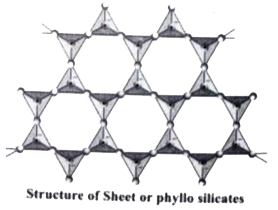Write a notes on
(i) Sheet silicates (ii) Three dimensional silicate
(i) Sheet silicates,
Silicates which contain (Si2O5)2n−n are called sheet or phyllo silicates. In these each [SiO4]4− tetrahderon unit shares three oxygen atoms with others and thus by forming twodimensional sheets. These sheets silicates form layered structures in which silicate sheets are stacked over each other. The attractive forces between these layers are very week, hence they can be cleaved.

easily just like graphite.
Example: Talc, Mica etc..
(ii) Three dimensional silicate: Silicates inwhcih all the oxygen atoms of [SiO4]4− tetrahedra are shared with other tetrahedra to form three dimensional network are called thre dimensiional or tecto silicates. They have general formula (SiO2)n.
Examples: Quartz These tecto silicates can be converted into Three dimentional aluminosilicates by replacing [SiO4]4− units by [AlO4]5− units E.g. Feldspar, Zeolites etc.
Topper's Solved these Questions
- p-BLOCK ELEMENTS -IBOOK - FULL MARKSCHAPTER - p-BLOCK ELEMENTS -IEXERCISE - Additional Questions - 3-MARK QUESTIONS
26 Videos
- P - BLOCK ELEMENTS - IIBOOK - FULL MARKSCHAPTER - P - BLOCK ELEMENTS - IIEXERCISE - Additional Questions (5 Mark Questions)
11 Videos
- SAMPLE PAPER - 11 (UNSOLVED) BOOK - FULL MARKSCHAPTER - SAMPLE PAPER - 11 (UNSOLVED) EXERCISE - PART - IV
3 Videos
Similar Questions
Knowledge Check
About 95% of the earth's crust is composed of silicate minerals, alumino silicate clay r silica. Silicates are classified on the basis of bonding and the metal ions present in them. Some of the common categories of silicates are
(I) orthosilicates , (II) pyrosilicates
(III) cyclic silicates , (IV) chain silicates
(V) amphiboles , (VI) sheet silicates
(VII) three-dimensional network silicates
Which of the following is not true regarding cyclic silicates ?AIts general formula (SiO3)2n−nBIt has two shared oxygen per tetrahedronCBoth Ca3[Si3O9] and Be3al2[Si6O18] are cyclic silicatesDPyroxene is a chain silicate but do not contain cyclic structureAbout 95% of the earth's crust is composed of silicate minerals, alumino silicate clay r silica. Silicates are classified on the basis of bonding and the metal ions present in them. Some of the common categories of silicates are
(I) orthosilicates , (II) pyrosilicates
(III) cyclic silicates , (IV) chain silicates
(V) amphiboles , (VI) sheet silicates
(VII) three-dimensional network silicates
What is true regarding a double chain silicate 'Amphiboles' ?AIt has two shared oxygen per tetrahedronBIts empirical formula is (SiO3)6n−nCIt is formed by joining two single chain silicates through free O−.DAll the four oxygen of the tetrahedraon are shared.About 95% of the earth's crust is composed of silicate minerals, alumino silicate clay r silica. Silicates are classified on the basis of bonding and the metal ions present in them. Some of the common categories of silicates are
(I) orthosilicates , (II) pyrosilicates
(III) cyclic silicates , (IV) chain silicates
(V) amphiboles , (VI) sheet silicates
(VII) three-dimensional network silicates
Which is incorrect regarding three dimensional netwirk silicates ?AIt is pure SiO2BIt has all four oxygen of tetrahedron sharedCFeldspars, zeolites and ultramarines are the common examplesDIt contains some isomorphously substituted Al3+ ion
Silicates are metal derivatives of silicic acid. Silicates are formed by heating metal oxide or metal carbonate with sand.
Na2CO3Fused with Sand−−−−−−−−−→SiO3Na4SiO4,Na2(SiO3) etc
A silicate in general has Si-O bond and possesses a complex network solid having silicate ion SiO4−4 as the basic structural unit. These silicates occurs singly or by sharing oxygen atom is small occurs singly or by sharing oxygen atom is small groups, in cyclic groups, in infinite chains or infinite sheets giving different structures to silicates such as chain silicates, ring silicates, cyclic silicates, sheet silicates, three dimensional silicates etc.,
Which of the following is ortho silicate ?
View SolutionSilicates are metal derivatives of silicic acid. Silicates are formed by heating metal oxide or metal carbonate with sand.
Na2CO3Fused with Sand−−−−−−−−−→SiO3Na4SiO4,Na2(SiO3) etc
A silicate in general has Si-O bond and possesses a complex network solid having silicate ion SiO4−4 as the basic structural unit. These silicates occurs singly or by sharing oxygen atom is small occurs singly or by sharing oxygen atom is small groups, in cyclic groups, in infinite chains or infinite sheets giving different structures to silicates such as chain silicates, ring silicates, cyclic silicates, sheet silicates, three dimensional silicates etc.,
Number of oxygen atoms in pyrosilicate is
View SolutionSilicates are metal derivatives of silicic acid. Silicates are formed by heating metal oxide or metal carbonate with sand.
Na2CO3Fused with Sand−−−−−−−−−→SiO3Na4SiO4,Na2(SiO3) etc
A silicate in general has Si-O bond and possesses a complex network solid having silicate ion SiO4−4 as the basic structural unit. These silicates occurs singly or by sharing oxygen atom is small occurs singly or by sharing oxygen atom is small groups, in cyclic groups, in infinite chains or infinite sheets giving different structures to silicates such as chain silicates, ring silicates, cyclic silicates, sheet silicates, three dimensional silicates etc.,
The general formula (SiO2−3)n forms
View SolutionWhich of the following is a three dimensional silicate
View Solution(A) ZSM-5 is used as a catalyst in petrochemical industries.
(R) Zeolites are three-dimensional network silicates in which some atoms are replaced by luminium atoms.
View Solution
